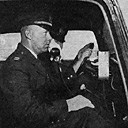Night Watch

The idea of reality as entertainment seems fairly modern. But if you ever listened to Night Watch, you know it’s nothing new. Instead of reality TV Night Watch is reality radio that aired from 1954-1955. The closest modern-day equivalent of Night Watch is the television show Cops.
Following the success of Dragnet, Night Watch was a crime documentary that highlighted real footage of real cases. The crimes were caught on tape as reporter Donn Reid wore a wire and rode along with police office Sergeant Ron Perkins.
The show was taped in Culver City, CA. Reid rode with the police on the night shift – from 6 p.m. to 2 a.m. when crimes were most likely to occur. By the time the show stopped airing, there were over 100 incidents caught on tape.
As the action unfolded, Reid caught it on tape and later aired it on Night Watch. It was completely unscripted with no special effects or any other kind of soundtrack. Because it showcased real situations, it was extremely exciting and dramatic. In fact, Donn Reid was shot at in one episode and he was also stabbed in a different episode.
The names of all the characters were changed to protect the identities of the victims and their families and the suspects under scrutiny. Locations were also changed to protect identities. However, these were the only things about the show that didn’t represent complete reality.
At the end of every show, Night Watch gave an epilogue letting listeners know what had happened to the criminals who were featured. They would also ask listeners to be good citizens and help local law enforcement to do their jobs.
One thing that’s interesting to note is that the technology used to produce this show was fairly primitive compared to what we use today. Large amounts of heavy equipment had to be taken to each crime scene. In addition, editing had to be done by literally splicing the tape to remove profanity and other unacceptable content from the tape. The result is a somewhat rudimentary editing job where you can clearly tell dialogue was cut. And in the 1950s much of what was said had to be filtered.
If you’re a fan of today’s reality programming, you’ll surely enjoy listening to this reality show from the 1950s and despite everything you’re hearing being real, the show still maintains its excitement and drama. Listen for yourself and find out how gripping these true tales can be!
Happy listening my friends,
